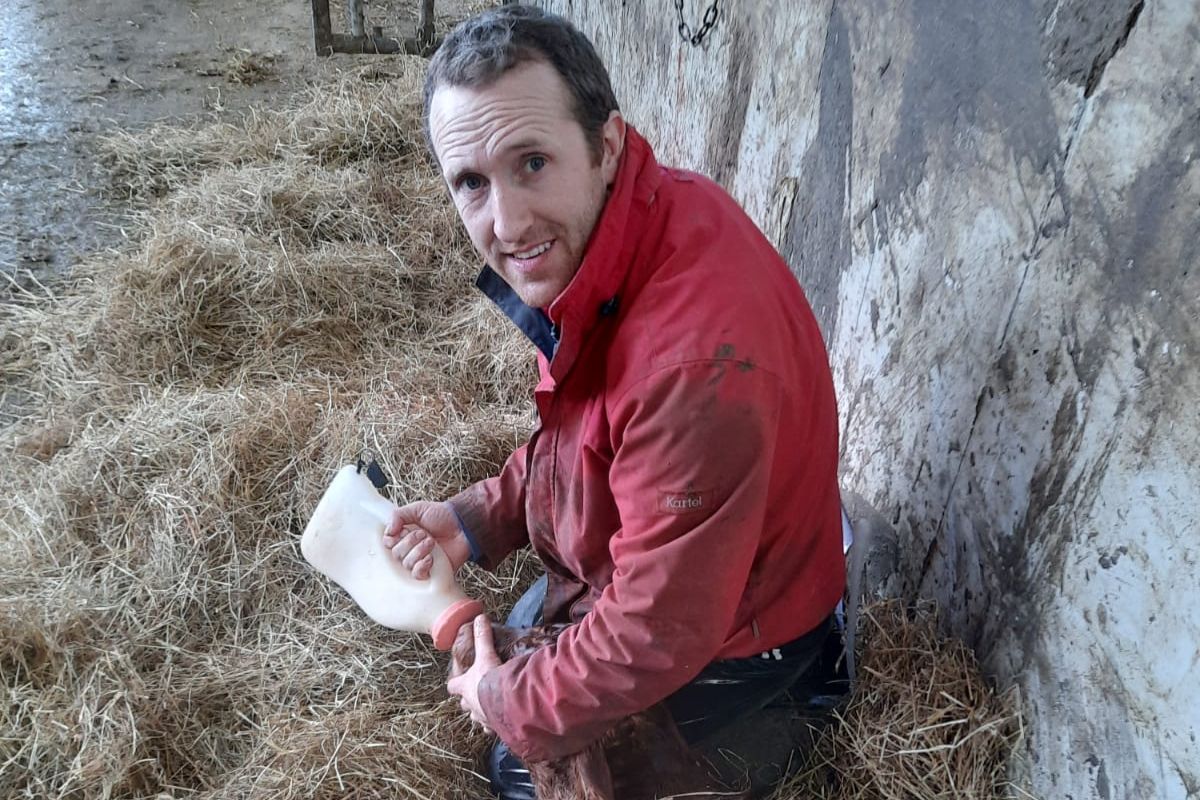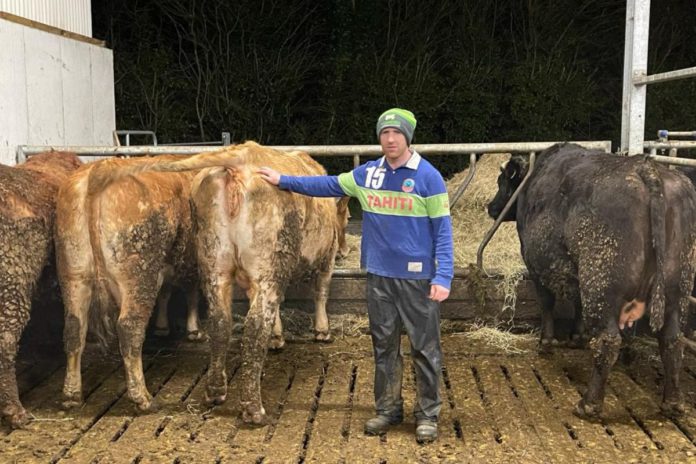In this week’s Suckler Farming Focus, Aonghusa Fahy, a part-time suckler farmer, who brings progeny to beef, and has land in two counties, provides an insight into his system and shares his thoughts on beef farming in Ireland.
Time management, planning, being open to new technology and practices, herd health, good genetics, infrastructure and evaluating each year are the cornerstones of successful suckler farming.
That is the view of Aonghusa Fahy, a 30-cow suckler farmer and teacher at Ennistymon Vocational School in County Clare, who is married to Olivia, with a 15-month-old daughter.
His home farm in Tullira, Ardrahan, County Galway, comprises 60-acres (33-acres of good arable land, with the rest being under forestry or waterlogged), with a 66-acre out-farm and a further 25-acres rented in Tulla, County Clare.
He took the reins of his family farm six years ago and had just begun transitioning from drystock to suckling the previous two years before farming in his own right.
“My father was a part-time farmer before I took over the running of the farm. He used to farm drystock and had a few horses. I spent my summers and weekends when I was young helping my two bachelor uncles on their suckler farms.” he told That’s Farming.
“Following my uncle’s death four years ago, I inherited his farm. This forced me to plan and implement effective grassland management practices and to develop my suckler beef enterprise. From a very young age, I owned a few cows on my uncle’s farm.”

Expansion
Before he inherited his uncle’s enterprise, he had 18 cows but now farms 30 cows as part of a grass-based system, bringing progeny through to beef.
“This came about as I was maxed out in my home farm with 30 cows and had a keen interest in finishing my own stock. My system allows me to keep my cow’s calves on my home farm in Tullira and drystock in Tulla.”
Furthermore, the part-time suckler farmer built a new 3-bay slatted shed with a creep in 2019 to expand his suckler farm.
In recent years, he has started buying dairy-cross heifer calves (in which he has selected the sire and dam) for replacements from local dairy farmers. He retains some females from the herd’s best cows and calves these as part of a 24-month-old system.
He farms an array of Limousin, Simmental, Charolais and Hereford-cross cows, which he breeds to a pedigree Limousin bull. The part-time farmer focuses on good milk, fertility and carcase conformation to develop hybrid vigour through cross-breeding.
He operates a spring-calving system, with the season kicking on in early February and finishing in 6-8 weeks, as he pulls his stockbull from the herd after eight weeks.

Breeding programme
Every year, he AIs all heifers, and last year, he attempted to synchronise half his cows and heifers, but this was not as successful as he had hoped.
“Recently, I have received the Moo Heat, and have I have vasectomised a bull. I will run ten cows and five heifers in the effort to get replacements. This should compact my calving season also.”
“Cows need to be able to rear their own calf as it suits my grass-based system. All cows must be docile and square (low and long). My ideal weight range is 650-750kgs; I try not to have them too heavy as this does not suit my grass-based system in spring and autumn.”
“I cull cows that are over 12-years-old, are not docile, or they are not performing. If a cow does not go in-calf, I do not give her another chance.”
“My calving interval is 360 days. I try to get calves to gain 1.4kg/day for males and 1.2 for kg/day heifers. Over the winter, the aim is to get bullocks to gain 0.8 kg/day, and heifers to gain 0.6 kg/day.”
“All calves are weighed three times during the summer and before they are weaned. I usually wean calves before I turn them out to grass. I weigh animals that are I am finishing at regular intervals.”
He sells superior weanlings at the mart and finishes heifers from 22-months, with a targeted carcass weight of 320-330kgs and aims to slaughter bullocks at 28 months with a 420kg carcass weight, with progeny grading R3s and U3s.
This year, he is finishing two young bulls under 16 months (620kg and 660kgs at 13 months) and 14 bullocks at 25 months (average weight 670kg) to meet BEAM reduction requirements.

Grassland management and animal performance
Along with setting livestock performance targets, grassland management is another important practice with 10% of the farms reseeded annually.
This year, the suckler farmer hopes to sow more white clover into his pastures through seed mixtures at reseeding and by sowing into weed-free fields.
He tries to cut silage in all paddocks at least once-a-year to maintain good quality swards.
“I measure grass with a grasshopper plate meter and use the Pasture Base system. I seek advice from my Teagasc advisor, Mícheál Kelly of Teagasc Athenry, on my spring and autumn rotation.”
“He has given me great advice on my development of a paddock system and grass measuring. I am in contact with him regularly, and he knows what is happening on-farm.”
“To juggle family life, farming, and teaching, I have a routine. Furthermore, I believe in keeping things simple and using technology, such as calving cameras, Moocall HEAT, Moocall, Herdwatch, Pasture Base and ICBF, to my advantage.”
“I have excellent contractors that I can rely on at home and in Tulla. They work with me so that I can still go out to work as a teacher. My parents, Michael and Nora, give a hand at calving time, and some family members will stand in a gap if needed when moving cattle.” the part-time suckler farmer added.
“My father-in-law, Cyril, gives me a hand on different farms with tasks such as testing, dosing, or fencing. I have a man feeding the cattle in Tulla, County Clare during the winter, and my uncle keeps an eye on stock there also.”

The next steps and thoughts on industry
Not one to rest on his laurels, he has plans to maximise his farms’ potential into the future, with genetic improvement and more reseeding among these goals.
In future, he would like to move to 100% AI all, but currently, public roads divide his land at home, and he does not have the required animal handling facilities.
“I have a few one and one-star cows that are underperforming. I am not satisfied with all my cow’s progeny as some are underperforming when they are slaughtered.”
“Good quality stock should always sell at a premium, and if you can control cost, I think suckler farming can hold its own in this current environment. I do not think feedlots are a good image for the beef industry in Ireland.”
“Furthermore, I think farmers should get a higher premium for quality home-bred stock that have been home-bred for the entirety of their life.”
“Besides, I think that factories penalise too much for being overweight when they feel like it. It seems they can sometimes do what they want when there is an oversupply of cattle.” the suckler-to-beef farmer concluded.
You can follow this suckler-to-beef farmer on Instagram by clicking here.





